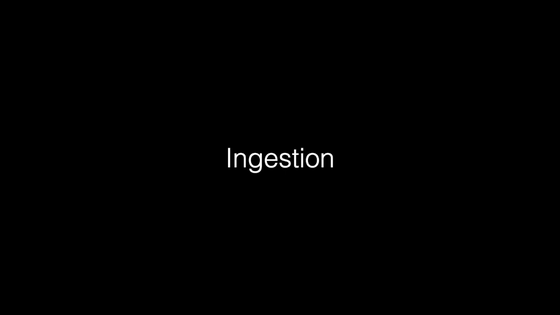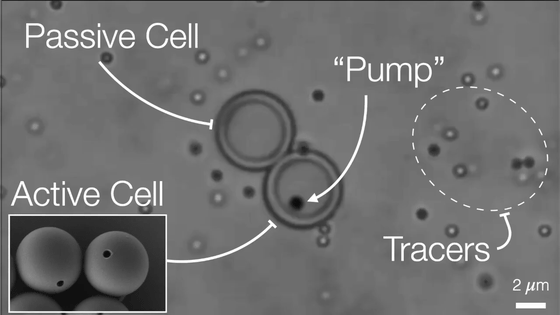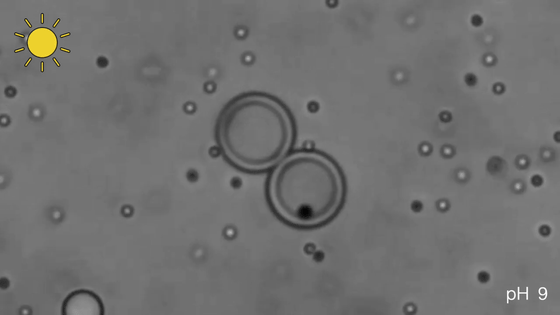Succeeded in developing artificial cells that ingest and excrete only specific substances such as 'PAC-MAN'

An American research team has announced that it has succeeded in reproducing the 'ability to ingest and excrete specific substances' of
Transmembrane transport in inorganic colloidal cell-mimics | Nature
https://www.nature.com/articles/s41586-021-03774-y
Scientists Create Artificial Cells That Mimic Living Cells' Ability to Capture, Process, and Expel Material
https://www.nyu.edu/about/news-publications/news/2021/september/artificial-cells.html
The basic function of a living cell is to 'collect energy from the surrounding environment and move molecules in and out of the cell,' which is called 'active transport.' Active transport uses energy to move molecules from low-concentration locations to high-concentration locations, and the cells of living organisms use this active transport to take in necessary molecules such as glucose and amino acids, store energy, and store energy. Discharges waste products.
For decades, researchers have been working on the development of 'artificial cells,' which are microstructures that mimic the characteristics and behavior of living cells. However, artificial cells have not been able to reproduce complex cellular processes such as active transport.
However, the latest research, published by a team of researchers at New York University and the University of Chicago in the scientific journal Nature, is one step closer to fully reproducing the function of living cells.

Artificial cells developed by the research team can autonomously ingest, concentrate, store, and transport specific substances when placed in a mixture of various particles. It mimics the active transport of cells, but artificial cells are made with minimal material and do not use any biological material.
To mimic active transport, the research team used polymers instead of cell membranes to control cell entry and exit to create red blood cell-sized spherical membranes. By making minute holes in this membrane, we have constructed nanochannels that imitate the protein channels of cells and are responsible for the transfer of substances.
However, in order to reproduce active transport, it is necessary to have a mechanism that attracts and expels substances by using a cell-like structure as a power source. In living cells, mitochondria and adenosine triphosphate (ATP) provide the energy needed for active transport. In artificial cells, by adding a chemically reactive component that functions as a 'light-activated pump' inside the nanochannel, a chemical reaction occurs when exposed to light, and the pump forms a vacuum state in the nanochannel, which is the target. Created a structure that can draw the substance to be inside. In addition, when the pump fails in the light, the substance is trapped in the nanochannel. In addition, by reversing this chemical reaction, it is possible to discharge substances from the nanochannel as needed.
You can see how artificial cells actually reproduce active transport in the following movie.
The process by which artificial cells ingest certain substances

The circle in the center of the image below is the artificial cell, the 'Active Cell' is in the active state, and the 'Passive Cell' is in the inactive state. 'Tracers' is a target substance that artificial cells ingest, and 'Pump' is a substance that artificial cells have successfully ingested.

When the icon on the upper left of the screen is yellow, it is a sign that the artificial cell is illuminated.

When exposed to light, it takes in more and more substances ...

When the light irradiation stops, the ingestion process also stops.

The inside of the artificial cell is filled with the target substance.

No material leaks from the artificial cells when not exposed to light.

The process by which artificial cells excrete specific substances

By reversing the ingestion process, it is also possible to expel the substances that have been taken in. When exposed to light, substances are discharged ...

When the light irradiation is stopped, the discharge stops.

Associate Professor Stefano Sakanna of New York University, the lead author of this study, said, 'The design concept of this artificial cell is to make artificial cell mimics operate autonomously, and it is active that was found only in living cells. It was to reproduce transport. An important part of the design of artificial cells is the synergistic effect of active elements that mimic the power inside the cell and the physical constraints imposed by the cell wall, thereby ingesting and processing foreign substances.・ We are discharging. '
The research team has tested these artificial cells in a variety of environments, and has also succeeded in collecting surrounding particles and impurities by exposing them to light in water. That's why Sakanna described the artificial cells they created as 'like Pac-Man in a game, eating pollutants around.'
In another experiment, we have also succeeded in collecting E. coli using artificial cells, suggesting the possibility of collecting only specific bacteria in the body. In addition, it is possible to shine light on the substances contained in artificial cells and expel them, so it may be used to carry drugs into the body in the future.
Related Posts:







